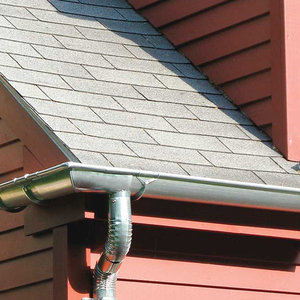Quick question: What is the max practical driveway grade for a short concrete driveway – maybe 25′ long x 18′ wide – they will basically just be off street parking places.
I have a SmartTool (digital level) and will be doing the checking of several lots first thing tomorrow AM before I meet with the developer.
I’d prefer to hear from people with professional, or at least first hand experience.
Weather here is mild – probably snow 3 days a year and ice 2 days a year.




















Replies
Oh - somebody's got to find that pic from a couple of years back where the driveways loked high enough to "high-center" the car as it went in the garage.
I think the suspicion was that they were photo shopped, but that reminded me.
Sorry, I don't have an answer for you, but this will bump the thread.
Adventures in Home Building
An online journal covering the preparation and construction of our new home.
Yea - I think I rember that pic - wasn't it 2 right next to each other?
Ask and ye shall recieve.
View Image
Beautiful
Note to Original Poster: this is too steep.
http://jhausch.blogspot.comAdventures in Home BuildingAn online journal covering the preparation and construction of our new home.
A friend of mine did this photoshop on the original picture.... :-)
View Image
12 percent is steep, 15 percent is scary. If you get snow, much less is better.
The most important part -- more than the slope -- is to have a flat spot where cars join traffic and where they stop at the end of the driveway.
Starting or stopping from a steep slope is annoying at best in bad weather, and can be dangerous.
In addition, you need a gradual change in slope, especially at the upper end, to avoid the high-centering problem illustrated with the photshopped picture, and to avoid dragging mufflers, etc, on the lower end.Of course, this need for a gradual change in slope takes away from the run of the sloped section, making it that much steeper. Especially on a short drive the difference between reasonable and unreasonable can be very small.
If Tyranny and Oppression come to this land, it will be in the guise of fighting a foreign enemy. --James Madison
Very important point. I get called to fix that one all the time. Thanks.
Thanks - that is exactly what I was looking for.
>> The most important part -- more than the slope -- is to have a flat spot where cars join traffic and where they stop at the end of the driveway. << Like I said, the driveways aren't going to be very long. The city requires the portion on the right-of-way to be along the line of 1/4" per foot, which is 9.5' long, then the 20' section.
Are you the guy I remember who does grading and the like in the upper mid west?
Dumb q- 12% is 5.5 degrees or 1' in 8.33' - right?
You're welcome.Nope, coldest I've ever been in my life was the upper mid-west. Ain't goin' back. <G>There are no dumb Q's -- 12percent is 6.8 degrees or 1-7/16 inch per foot.
Is this correct?
45o = 1:1 = 100% = 12” per foot
22.5o = 2:1 = 50% = 6” per foot
15o = 3:1 = 33% = 4” per foot
11.25o = 4:1 = 25% = 3” per foot
5.625o = 8:1 = 12.5% = 1.5” per foot
2.8125o= 16:1 = 6.5% = .75” per foot<!----><!----><!---->
Edited 8/30/2006 6:36 am ET by Matt
A little late but here you go...
I've found 14% very acceptable. Know from experience that 30% textured concrete is slick as snot when it rains. A recent survey I did of an existing driveway showed 21% in the problematic areas, which will get regraded to 17%. With asphalt grindings, will work. 14% was unattainable (small lot).PAHS Designer/Builder- Bury it!
When I was reasearching FHB's driveway article some years back, I was surprised to find a range of allowable maximum grades. Here in CT and where I lived in Jersey, 15% is the max. In flat states, inspectors told me 10%. The guy from Colorado told me 18%.
The right answer is as flat as possible without creating a pond.
BTW, here in CT, some of our roads are 20%. They are very, very hard to pedal a bicycle up, but a lot of fun to ride down.Andy
"Never try to teach a pig to sing. It wastes your time and annoys the pig." Robert A. Heinlein
"Get off your dead #### and on your dying feet." Mom
I'll paste in here an aside regarding grade. There's supposed to be a graphic in the blank area that shows angle A as the angle of incline, so tan A = rise/run.
===============================================
Q) What is the road gradient (percent of incline)? <!----><!----><!---->
A) The percent of incline is its vertical rise (or drop), in feet, per every 100 horizontal feet traversed. This is also known as the tangent. (I say "feet" for clarity; one could use any consistent length measure.) <!----><!---->
tangent A = % of grade (Multiply by 100 to express as a percentage.) <!----><!----> <!----><!----><!----><!----><!----><!----><!----><!----><!----><!----><!----><!----><!----><!----><!----><!----><!----><!----><!----><!----><!----><!----><!----><!----><!----><!----><!----><!----><!----><!----><!----><!----><!----><!----><!----><!----><!----><!----><!---->
Q) When indicating the slope of an incline, which is more commonly used, percent or degrees? <!----><!---->
A) The incline of a road is generally measured in % grade, which in mathematical terms is the tangent (A) of the angle measured from the horizontal (b). This is the ratio of elevation change per horizontal distance traveled, often called "rise over run or pitch". Typically a road that rises 1-in-10, is otherwise called a 10% grade (if b=100 and a=6 then tangent A=.06 or 6% grade). <!----><!---->
Q) Why use percent of incline vs. degree of angle? <!----><!---->
A) The reason for using percent of incline instead of angle is that percent gives a direct way to assess the effort required to move forward against the grade, whereas the angle in degrees does not readily reveal this information. For example; a 5% grade requires a forward force equal to 5% of the weight of the object (above and beyond the force it takes to overcome surface resistance on flat ground at the same speed). <!----><!---->
This came up the other day because of a very unusual situation. Now here we think of a grade as 1% and a hill as 3%. Flatlanders, you know. Now I was told that the max allowable was 10% but wasnt able to find out at the time (hey, wasnt my job) if that was some kind of code thing or just local municipality rule. But man, a 10% grade on a drive, I wouldnt want that. I'd make the drive pitched just enough to shed water and use retaining walls around it, incorporating drainage into the slab,if that was necessary.
Now that does happen with a walkout here periodically. Garage goes on the "basement" level and is a side loader. You'll typically see the face of the house, or high side, with a retaining wall swept along the drive, and sometimes a metal grate, maybe 3 or 4" wide, where a relief cut would be. That just drains out into the yard.
"Sometimes when I consider what tremendous consequences come from little things, I am tempted to think -- there are no little things" - Bruce Barton
These are up-sloped lots (from the road). Some have solid rock below where the drive needs to go. If they were downslope lots it would be no prob (just $$s). We have plenty of crushed rock to use as fill.
Was designing a parking garage for a small urban lot a year ago. Keep ramp slopes below 20%. Between 10% and 20% requires a minimum 8'-0" transition strip at the top and bottom to keep from bottoming out.
Thanks everyone.
I measured the existing grades this morning, and without running out to my truck I recall between 12 to 22 degrees. I'm pushing for a max of 12% but the developer pretty much blew me off on that point at the meeting this morning and mumbled something about a $6K lot cost increase. So, it remains to be seen who is gonna pay for this major excavation. Only thing I know for sure is who is not gonna build driveways on it...
It's back on the back burner for now...
PS - exterior concrete on private property is not inspected here so state/municipal/etc codes don't come into play here.
Edited 8/30/2006 7:28 pm ET by Matt